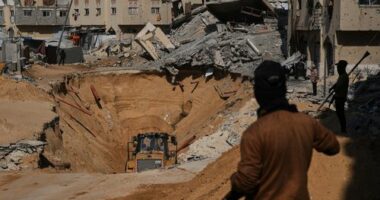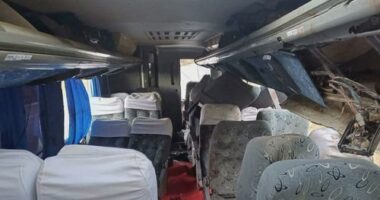Share this @internewscast.com
Recovery teams working until late on Friday found at least 25 more bodies in the debris, officials said.

Dr. Dhaval Gameti at the Civil Hospital in Ahmedabad told The Associated Press the facility had received 270 bodies, adding that the lone surviving passenger was still under observation for some of his wounds.
“He is doing very well and will be ready to be discharged anytime soon,” Gameti said on Saturday.
Hundreds of relatives of the crash victims have provided DNA samples at the hospital. Most bodies were charred or mutilated, making them unrecognisable.
Some relatives expressed frustration Saturday that the process was taking too long. Authorities say it normally takes up to 72 hours to complete DNA matching, and they are expediting the process.
“Where are my children? Did you recover them?” asked Rafiq Abdullah, whose nephew, daughter-in-law and two grandchildren were on the flight.
“I will have to ask questions. Government is not answering these questions.”

Another relative persistently asked hospital staff when his relative’s body would be handed over to the family for last rites.
“Give us the body,” the relative insisted.
Alongside the formal investigation, the Indian government says it has formed a high-level, multi-disciplinary committee to examine the causes leading to the crash.
The committee will focus on formulating procedures to prevent and handle aircraft emergencies in the future and “will not be a substitute to other enquiries being conducted by relevant organisations,” the Ministry of Civil Aviation said in a statement.

India’s Aircraft Accident Investigation Bureau said it had started working with “full force” to extract the data.
The device is expected to reveal information about the engine and control settings, while the voice recorder will provide cockpit conversations, said Paul Fromme, a mechanical engineer with the UK-based Institution of Mechanical Engineers.
Aviation safety consultant Jeff Guzzetti, a former crash investigator for both the US National Transportation Safety Board and Federal Aviation Administration, said investigators should be able to answer some important questions about what caused the crash as soon as next week as long as the flight data recorder is in good shape.

Investigators likely are looking at whether wing flaps were set correctly, the engine lost power, alarms were going off inside the cockpit and if the plane’s crew correctly logged information about the hot temperature outside and the weight of the fuel and passengers, Guzzetti said.
Mistakes in the data could result in the wing flaps being set incorrectly, he said.
Thursday’s Air India crash involved a 12-year-old Boeing 787. Boeing planes have been plagued by safety issues on other types of aircraft.
There are currently around 1200 of the 787 Dreamliner aircraft worldwide, and this was the first deadly crash in 16 years of operation, according to experts.













